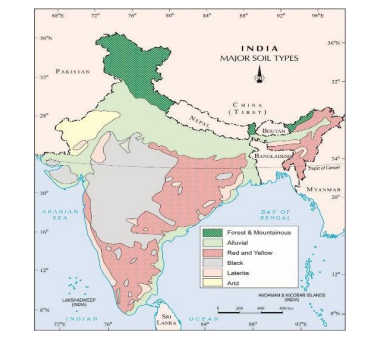
The soils of India serve as a vivid canvas, portraying the intricate tapestry of the country’s geological history and environmental processes. Each patch of soil tells a compelling tale of the complex interactions between climate, topography, vegetation, and human activities that have shaped the land over millennia. From the fertile alluvial plains nurtured by ancient rivers to the arid expanses where the forces of nature have sculpted unique soil profiles, India’s diverse soils embody a rich narrative of geological formations and dynamic processes. These soils are not just physical entities; they are repositories of the nation’s agricultural heritage, environmental challenges, and cultural nuances. In this way, understanding the soils of India becomes a profound exploration into the very essence of the land, encapsulating its past, present, and future.
Contents
Answer
The soils of India are clear reflections of the structure and process of the country’s diverse landscape and climate. The varied geological formations, relief features, and climatic conditions have resulted in a wide range of soil types across the country. The Indian Council of Agricultural Research (ICAR) has classified Indian soils into eight major groups:

- Alluvial soils
- Black soils
- Red soils
- Laterite soils
- Arid soils
- Mountain soils
- Forest soils
- Peaty soils
Alluvial Soil
- The structure of alluvial soil is a reflection of the processes that formed it.
- Alluvial soil is typically composed of layers of sediment of different sizes and textures.
- The size and texture of the sediment particles are determined by the speed and turbulence of the river or stream that deposited them.eg Fast flowing rivers deposit coarse-grained sediment, such as sand and gravel. Slower-flowing rivers and streams deposit fine-grained sediment, such as silt and clay.
- Alluvial soil is typically composed of layers of sediment of different sizes and textures. This layered structure is a reflection of the different flow conditions that occurred during the deposition of the sediment.
- Fertility of the soil reflects the influence of process of deposition. Every year rivers are subjected too flooding which result in flooding of the floodplains, resulting in renewal of the Khadar flood plains.
- Since they are transported soils, they do not get much time to develop fully as mature soils thus these soils are poorly developed with a poorly developed soil profile-Inceptisols.

Red Soil
- Clear reflection of the processes involved in their formation i.e., desilication.
- Desilication is the process of removal of silica from soil. It is a common soil formation process in humid tropical and subtropical regions, where high rainfall and temperatures accelerate the weathering of silicate minerals
- Desilication can lead to a number of changes in soil properties, including:
- Reduced fertility:
- Silica is an essential nutrient for plants. When silica is removed from soil, it can reduce plant growth and yield.
- Increased acidity
- The weathering of silicate minerals releases acids into the soil.
- This can increase the acidity of the soil and make it less suitable for plant growth.
- Reduced water retention
- Silica helps to bind soil particles together.
- When silica is removed from soil, it can make the soil more susceptible to erosion and reduce its ability to retain water.
Laterite Soil
- Reflect the influence of soil forming process of laterization
- Lateralization is a soil formation process that occurs in tropical and subtropical regions with high rainfall and temperatures. It is characterized by the removal of silica and other soluble elements from the soil, leaving behind a residue of iron and aluminium oxides.
- Laterite soil takes thousands of years to form. High ground is more likely to have older soils than low ground, which gives laterite soil more time to develop this explains presence of laterite soil in the Deccan Plateau region indicating strong reflection of structure.
Black soil
- A clear reflection of structure can be seen as parent rock on which black soil developed in India is basalt
- Basalt is more prone to weathering processes thus the small grain structure with high water holding capacity.
Soils also play an important role in regulating the hydrological cycle and in filtering pollutants. It is important to manage the soils of India sustainably. This includes protecting them from erosion, degradation, and pollution. Soil Health Card Scheme, Integrated Watershed Management Programme, and National Mission for Sustainable Agriculture (NMSA) are steps in the right direction.
In case you still have your doubts, contact us on 9811333901.
For UPSC Prelims Resources, Click here
For Daily Updates and Study Material:
Join our Telegram Channel – Edukemy for IAS
- 1. Learn through Videos – here
- 2. Be Exam Ready by Practicing Daily MCQs – here
- 3. Daily Newsletter – Get all your Current Affairs Covered – here
- 4. Mains Answer Writing Practice – here

